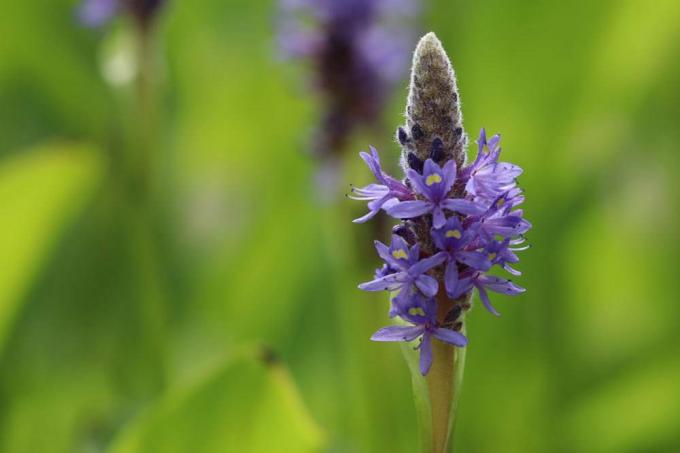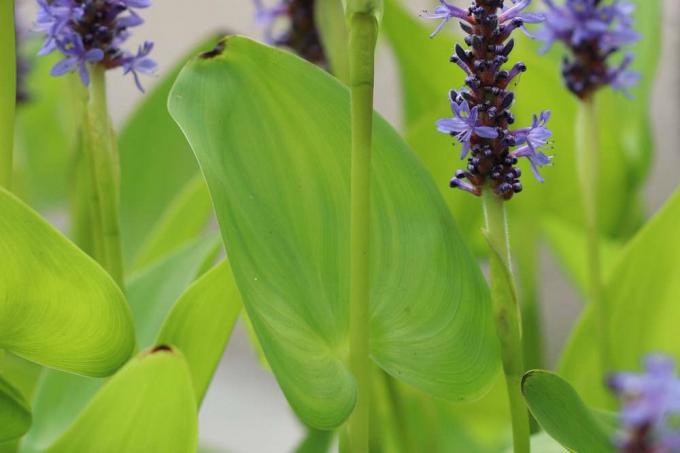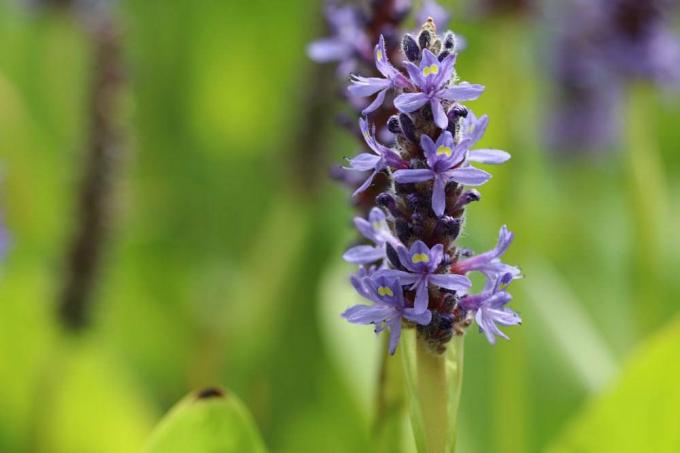
table of contents
- care
- Location
- plants
- to water
- Fertilize
- Cut
- Overwinter
- Multiply
- Diseases
Profile and care information open +conclude -
- Flower color
- purple, blue
- Location
- Partial shade, sunny, full sun
- Heyday
- June July August
- Growth habit
- upright, spreading, bushy, perennial, perennial
- height
- up to 100 centimeters high
- Soil type
- sandy, loamy, gritty, clayey
- Soil moisture
- very damp, wet
- PH value
- neutral, weakly alkaline, weakly acidic
- Limescale tolerance
- Calcium tolerant
- humus
- rich in humus
- Poisonous
- no
- Plant families
- Water hyacinth family, Pontederiaceae
- Plant species
- Pond plants, Aquatic plants
- Garden style
- Bog bed, water garden
The heart-leaved pike herb, botanically Pontederia cordata, with its blue to purple flowers is an extraordinary pond plant that does not have high maintenance requirements. As a solitary plant or planted in groups, it harmonizes very well with swan flowers or frog spoons. Not only hobby gardeners enjoy it, but also bees and dragonflies. Small fish also like to use the plants as protection from enemies.
care
Pontederia (heart-leaved pike herb) is one of the easy-care aquatic plants. As a marsh plant, it does not make high demands on care. Only that which has faded should be cut off. This will also prevent the plant from multiplying unchecked. In addition, the plant should be raised regularly Pestssuch as aphids or mealybugs.

Location
The plant grows in its home in swamps in the coastal region. In North America it takes root in the loamy and muddy ground when the water level is low. The aquatic plant belongs to the Emersen, i.e. water or water plants rooted in the ground. Marsh plants. Therefore, for Pontederia cordata, the shallow water zone is im garden pond the ideal location.
- Shallow water or swamp zone of the garden pond
- Bog gardens
- larger tubs or other containers
- full sun or partial shade depending on the variety
Substrate
As a marsh plant, the heart-leaved pike herb loves muddy, soft soil. The ideal substrate for the plant is the following.
- muddy-sandy
- low in lime
- nutrient-rich (pond soil)
- Planting depth: 30 to 60 centimeters

Normal garden soil, on the other hand, is not recommended as a substrate. Since it has a very high nutrient content, this can promote the formation of algae in the pond.
plants
Pontederia (heart leaved pike herb) can be planted as a solitary or in groups. The interplay of several plants with the swan flower or the frog spoon is particularly beautiful. So that the marsh plant can develop properly, it needs a planting distance of around 25 centimeters.
- Plant out in spring or summer
- Plant basket with pond soil
- pure gravel in nutrient-rich ponds
- Weigh down the basket with stones
- Layer of coarse sand or grit on the surface of the earth (prevents washout)
Tip: Put a maximum of four plants per square meter.
The marsh plant is not hardy. Therefore, it should be planted in a plant basket. This makes it easier for the plant to move to winter quarters after the summer season.
Tip: Pontedria tends to grow strongly. Therefore, the plant basket is not only used for transport to winter quarters. It also curbs growth.
to water
As a water plant, Pontederia cordata does not need to be watered. Make sure, however, that the plant is always in sufficient water. If the water level in the pond drops, cover the plant with leaves or peat. This protects the plants from drying out in the worst-case scenario. If the water level in the pond permanently exposes the plants, take further countermeasures. Because the marsh plant must not dry out completely.

Fertilize
The aquatic plant receives sufficient nutrients in the garden pond. Additional fertilization is not required. Only fertilize the plant if it shows signs of deficiency. These include yellow leaves or puny flowers. Since fertilization measures can very quickly affect the fauna and flora of the pond, only use special fertilizers for ponds or ponds. Aquatic plants.
- Chopsticks or cones or
- Liquid fertilizer for pond or Aquatic plants
Cut
Pontederia cordata (heart-leaved pike herb) is easy to care for. Cutting back is not absolutely necessary. Still, it should be cut every now and then in small ponds.
So that the marsh plant grows densely and develops flowers, pruning is recommended in spring. During the flowering season, withered material and inflorescences should be cut off. Another cut is necessary for wintering in autumn.
Tip: Use a sharp knife that is as clean as possible to cut off the faded.
Toxicity
The leaves and seeds of the pike herb are not poisonous. The plant is no problem for gardens with children or pets.
Overwinter
Although Pontederia is not hardy, it can weather the cold season outdoors if it gets enough winter protection. In order to be able to transport the water plant more easily, it is best to plant it in a plant basket. For the winter months, it can easily move to the frost-free deep water zone of the garden pond. The water depth should be around 50 centimeters.

Since the aquatic plant pulls in most of the above-ground parts in late autumn, it can also overwinter in a dry location. To do this, however, it must be hammered in and covered with a thick layer of leaves. Another possibility for wintering is in the house. A frost-free, unheated, bright room is suitable as winter quarters. The following applies: the warmer the room, the lighter it should be. Alternatively, the plant can also overwinter in a cold water aquarium. In spring, the marsh plant sprouts again and can then move back to its summer location.
Tip: Before wintering, cut off all dried-up parts of the plant.
Multiply
Pontederia can be propagated vegetatively or by seeds.
Vegetative propagation
This is the easiest way to propagate the aquatic plant. Over time, the rhizome begins to grow in the soft soil. From this so-called creeping rhizomes drive daughter plants out.
For propagation:
- carefully divide the rhizome
- cut off young rhizomes
- a sharp knife is the ideal tool
- Division before or after wintering
Seeds
When propagating with seeds, these are collected by the plant in autumn or spring. The ideal time for sowing is in spring. Store the seeds in a cool and moist place. If the seeds are to be stored for a longer period, their surroundings should be as dry and cool as possible.
- Put in a bowl with a few centimeters of water
- sandy-loamy substrate
- at a temperature of 15 to 25 degrees Celsius
- bright location
- no direct sunlight
- Plants must not dry out
- possibly. Give in to water
- Plant out from the end of April
Tip: When the young pike weed grows above the surface of the water, place the young plants in an aquarium with a water height of around 10 centimeters.

Diseases
Diseases and pests
The beautiful aquatic plants are not very popular with pests. Only aphids occasionally attack Pontederia. They like to stick to the underside of the leaf. Aphid infestation is often associated with the arrival of sooty fungi. The fungus penetrates the plant through the lice's sucking points.
If brown or black spots appear on the leaves, it is usually the so-called. Leaf spot disease. The plants get sick if the water is too hard or if they get too little light. Get the plant out of the water and cut off the diseased leaves generously. Check the site conditions before reseating.
